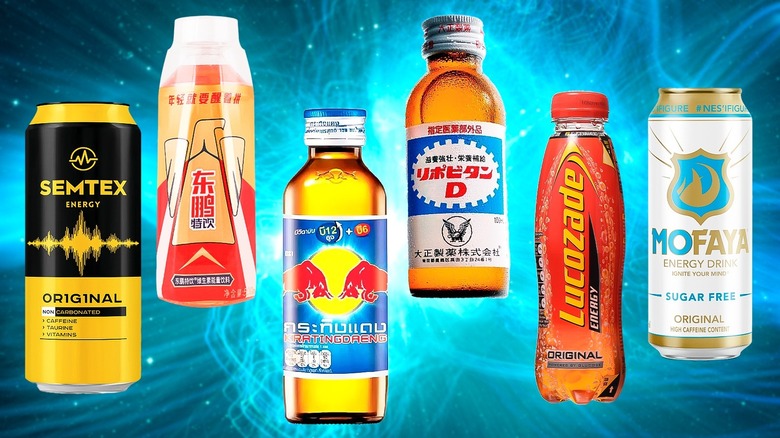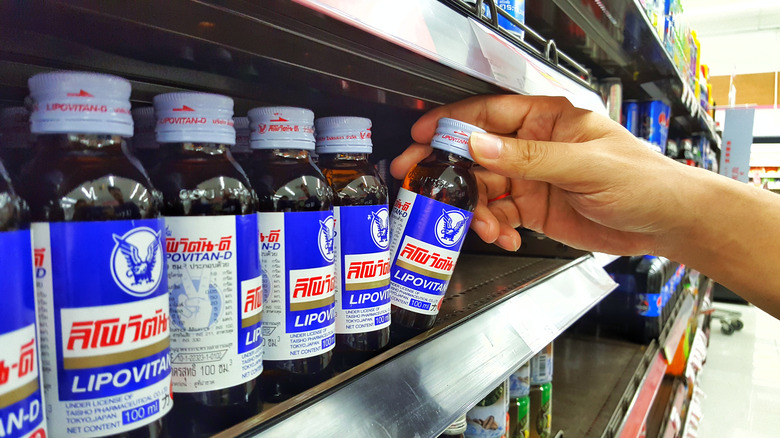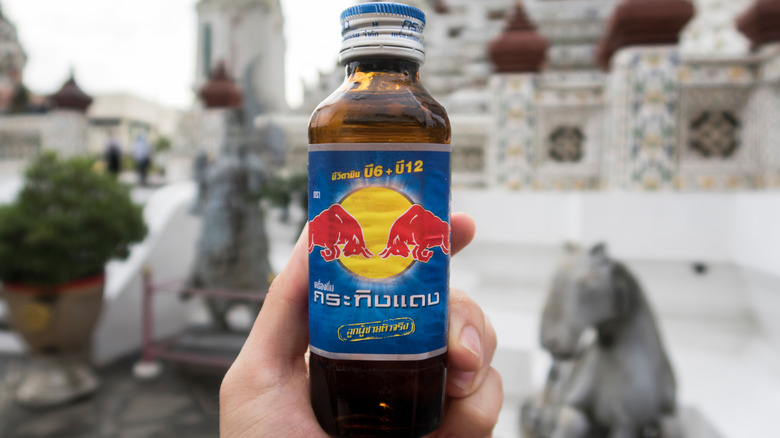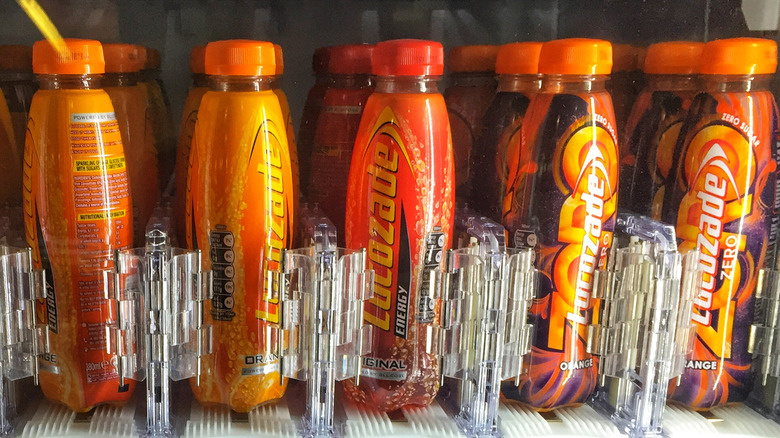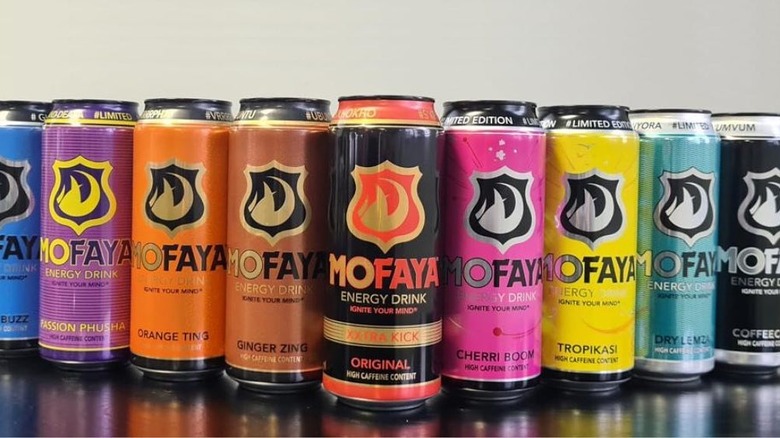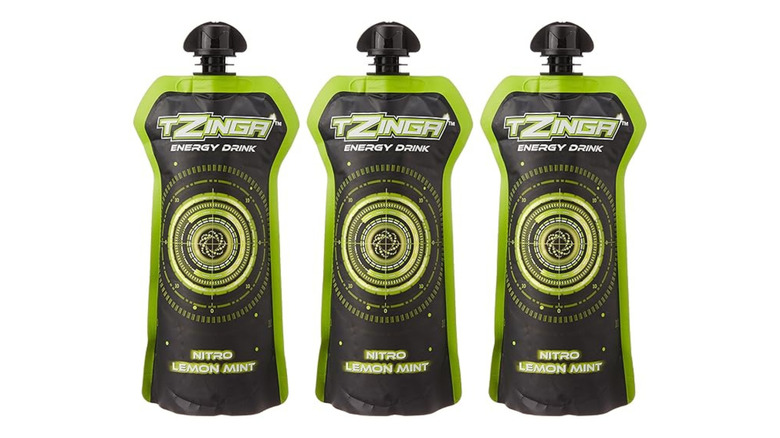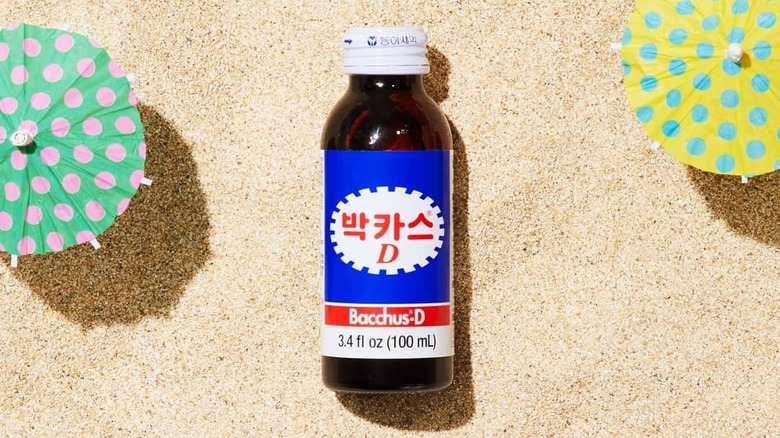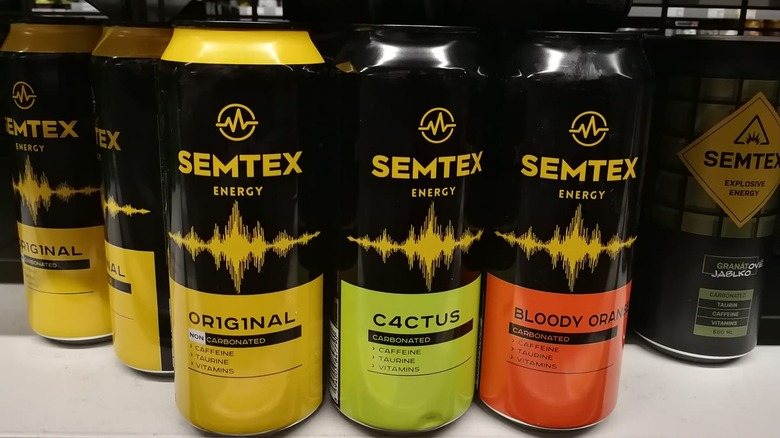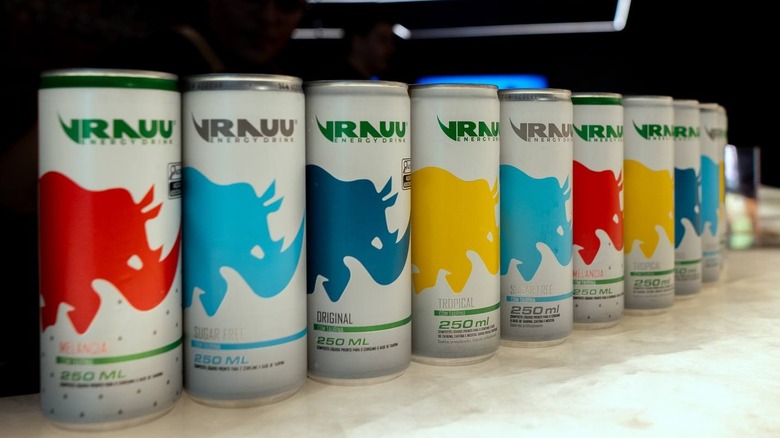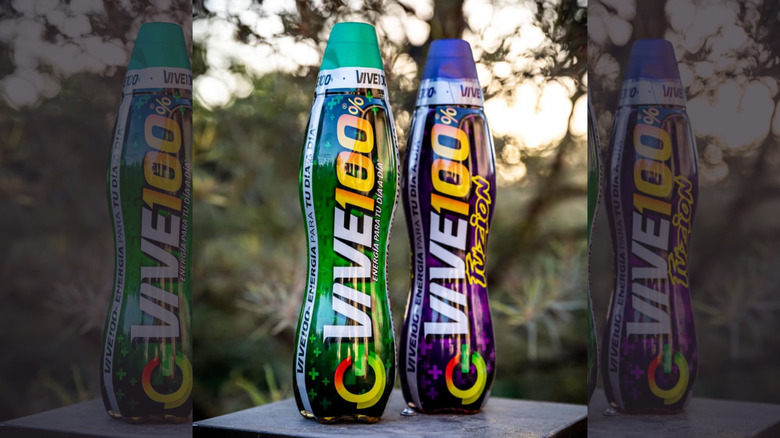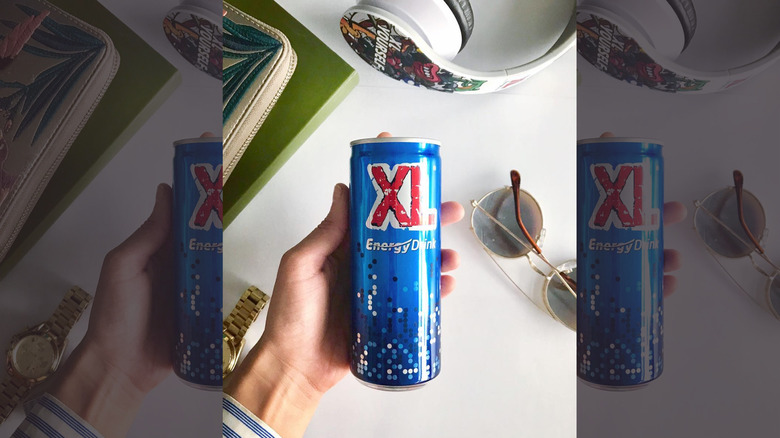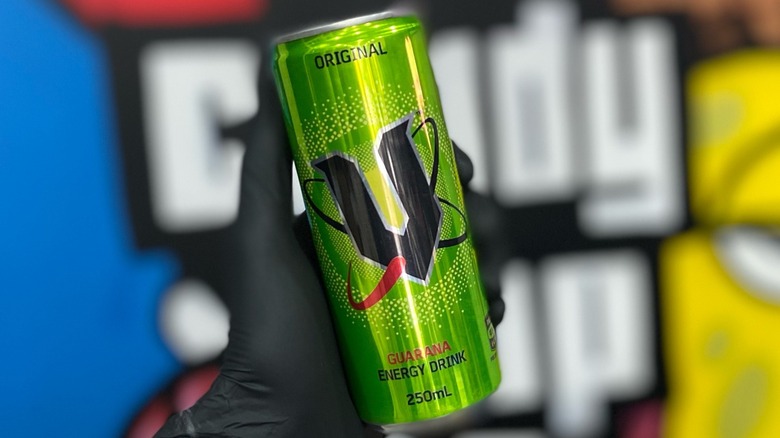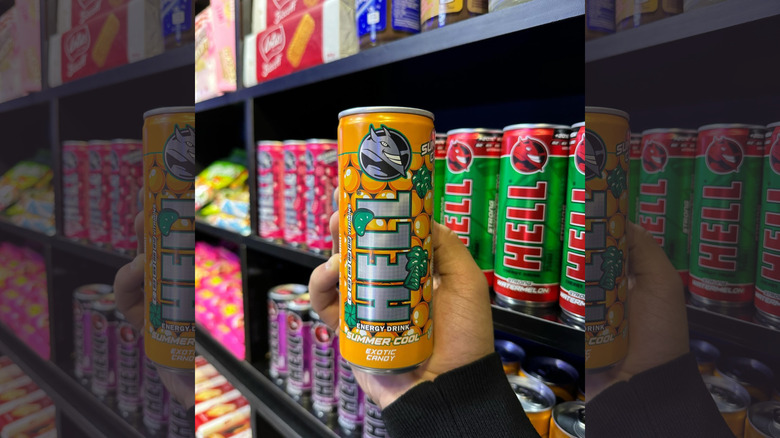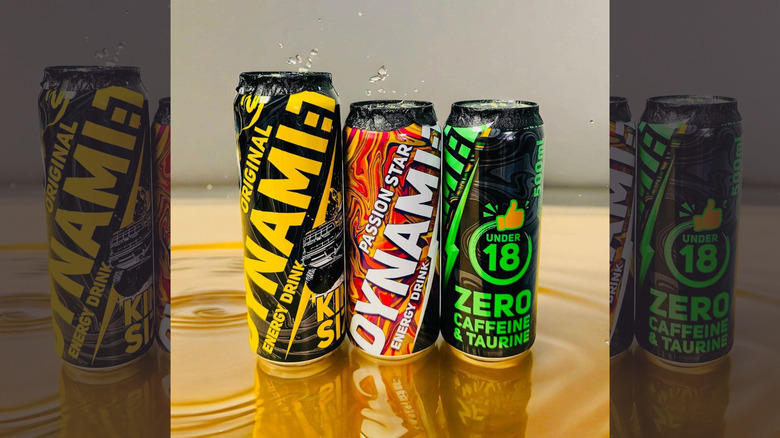13 Energy Drinks From Around The World
We've all had moments when we could do with some extra pep in our step — something to make us a bit more alert, stave off tiredness, and give our minds and bodies a burst of vigor. This desire isn't unique to modern-day humans, as we've been taking advantage of nature's stimulant — caffeine — for millennia.
The ancient Chinese consumed it in the form of tea, while coffee arose in Africa before spreading throughout the globe via the Middle East. For Mesoamericans, it was cacao that enhanced their physical and mental performance, with the belief that the gods themselves had imbued the beans with revitalizing powers. While we still enjoy the benefits of these drinks today, modern food science has allowed us to concentrate caffeine and other stimulating additives into a new generation of energy drinks.
These modern formulations can be found in every corner of the planet, with countless flavors available. While energy drinks typically contain sugar to increase their potency, healthier alternatives with more natural ingredients have recently become highly popular. Before we look at some of the different energy drinks you can find around the world, it's important to mention that there's a limit to how much caffeine we can safely consume. According to guidance from the FDA, the recommended limit is 400 milligrams per day — roughly equivalent to four cups of coffee — but this can vary from person to person. Caffeine can also become addictive, so energy drinks should always be approached with moderation in mind.
Lipovitan D - Japan
By the 20th century, there was no shortage of stimulants available to the general public; however, this wasn't necessarily a good thing. Most people have heard about how the first iterations of Coca-Cola contained coca leaf extract, the same plant used to derive cocaine. Amphetamines were also commonly used across the world, and the first modern energy drink still in existence was the result of Japan taking steps to reduce the use of this particular family of chemicals.
In 1962, Taisho Pharmaceutical Company introduced Lipovitan, a caffeinated herbal energy tonic. Lipovitan also contained taurine, a naturally occurring, antioxidizing amino acid that's prevalent in almost all modern-day energy drinks. Interestingly, taurine isn't a stimulant itself, but it's believed to reduce the anxiety associated with consuming higher quantities of caffeine. Lipovitan is sold predominantly in Asia under a variety of names and with a few different versions available. The standard product — Lipovitan-D — comes in a 100-milliliter bottle that contains 50 milligrams of caffeine and 1,000 milligrams of taurine. It also contains 5 milligrams each of vitamins B12 and B6, as these help our bodies metabolize sugars into energy, increasing the drink's effectiveness.
Krating Daeng - Thailand
The world's best-selling energy drink is undoubtedly Red Bull, with over 7 billion cans sold every year. The brand as we know it came from Austria in 1987, but Red Bull actually originated on the other side of the planet in Thailand, one decade earlier. Krating Daeng — which literally translates to "Red Bull" in Thai — was the invention of a chemist named Chaleo Yoovidhya. Yoovidhya wanted to develop an energy-boosting beverage for Thai truckers and laborers, and his product eventually caught the attention of a visiting Austrian entrepreneur, Dietrich Mateschitz.
Although Yoovidhya and Mateschitz joined forces to formulate a product more suited to Western consumers, Krating Daeng is still hugely popular in Thailand today. While Red Bull boasts dozens of unique flavors, Krating Daeng largely remains unchanged. The most popular version is a non-carbonated concentrate sold in 150-milliliter bottles that contain 50 milligrams of caffeine, 800 milligrams of taurine, and a variety of B vitamins. It also contains a hefty 25.6 grams of cane sugar, along with other natural sugars to provide an even bigger energy boost.
Lucozade Energy - United Kingdom
Before the likes of Red Bull and Monster hit stores across the pond, there was one energy drink brand that ruled them all — Lucozade. Invented in 1927 by an English pharmacist called William Walker Hunter, it was originally sold under the name Glucozade and marketed as a medicinal beverage.
By the 1950s, Lucozade was being promoted as a form of energy drink, and by the 1980s, the product was completely rebranded as a sports drink. New flavors also emerged, with orange and lemon versions being the first variants created to complement the original's vaguely citrusy profile. In the years since, Red Bull and Monster have overtaken Lucozade in terms of popularity, but it remains a British favorite. A variety of flavors have joined the line-up, including some limited editions. There's also a Zero range that replaces sugar with artificial sweeteners, and a non-carbonated Sport range. Although Lucozade is still referred to as an energy drink, it contains just 12 milligrams of caffeine per 100 milliliters — roughly the same amount of caffeine as a cup of tea. Although this won't give you the same kick as most other energy drinks, it might be a more suitable alternative for those with a high sensitivity to caffeine.
MoFaya - South Africa
Launched in 2015, MoFaya is a Black-owned South African brand that's gained huge popularity thanks to its dedication to celebrating its African roots and a wholesome entrepreneurial spirit. It began as the brainchild of Sibusiso Leope, an award-winning media personality, author, actor, and philanthropist. Leope, who goes by a performing name, DJ Sbu, has managed to grow MoFaya into a brand that truly represents African pride.
MoFaya has collaborated with a huge range of inspiring and influential Black South Africans over the years, putting resources into all manner of charitable endeavors. Its energy drink range has expanded to include all sorts of creatively named varieties, such as Cherri Boom, Passion Phusha, Flavatron, and Vitamin Ting. There's also a sugar-free version of the original for the more health-conscious customer. Each 500-milliliter can of MoFaya Original contains 160 milligrams of caffeine, which is roughly equivalent to the amount you'd find in a 500-milliliter can of classic Red Bull. However, each of these cans contains just 8.6 grams of sugar, which is a lot less than most other energy drinks that aren't sugar-free.
Tzinga - India
When the founders of Tzinga's parent company, Hector Beverages, decided to enter India's highly saturated energy drink market in 2011, they were well aware that they were engaging in a risky venture. The concept was first dreamed up by two friends — Neeraj Kakkar and James Nuttall — who'd first met at the University of Pennsylvania's prestigious Wharton Business School. Kakkar went on to work for Coca-Cola, and when the time was right for the two men to launch their own business, he enlisted the help of two of his ex-colleagues.
The key to Tzinga's success is arguably its extremely low price, with its range of energy drinks dramatically undercutting the cost of its market competitors. In 2016, Hector Beverages was forced to reformulate Tzinga, as India's food safety authority deemed it unsafe to combine caffeine with ginseng — a root that can amplify caffeine's stimulating effects. Despite this setback, Tzinga's popularity has continued to grow, despite sticking to a relatively core flavor range of Mango Strawberry, Lemon-Mint, and Tropical Trip. Unlike most energy drinks, Tzinga tastes like a non-carbonated fruit juice and comes in pouches as well as cans, with each containing 30 milligrams of caffeine per 100 milliliters and 400 milliliters of taurine.
Bacchus - South Korea
Named after the Roman god of wine and agriculture, the Bacchus brand was first launched in South Korea in 1961; however, it didn't start out in liquid form. Dong-A Socio Group — a pharmaceutical and beverage manufacturer — originally released Bacchus as a pill intended to promote personal health. A few years later, it was reformulated into Bacchus F, with another variant, Bacchus D, following suit.
Bacchus D comes packed with ingredients aimed at boosting energy and stamina, including 30 milligrams of caffeine and a whopping 2,000 milligrams of taurine in each 100-milliliter bottle. It also contains a range of B vitamins, and royal jelly — a honey bee secretion which proponents claim has a wide range of medicinal properties. Bacchus D also features Korean ginseng, which increases its stimulating properties but means the drink should be consumed in moderation. In recent years, Bacchus D gained some measure of popularity in the form of a "Bacchus Bomb," a college student favorite that involves mixing the drink with a shot of vodka. However, it's worth bearing in mind that mixing alcohol and caffeinated drinks can have risky side effects, so it might not be a combo to try at home.
Semtex - Czech Republic
First released in 1995, Semtex was the first energy drink to come out of Czechoslovakia, or the Czech Republic as it's known today. It immediately gained huge popularity and became one of the country's most recognizable homegrown brands, albeit not without some controversy.
Semtex was named after a type of plastic explosive that was also invented in Czechoslovakia, but the legal issue it faced wasn't due to the violent nature of its namesake. Rather, Semtex is a trademarked name. It took some time for the drink's manufacturers to make a financial settlement with the creator of the explosive, but it was eventually permitted to continue using the Semtex name. It wasn't the only one to hit this snag either — some years later, pop superstar Madonna encountered the same legal pushback after attempting to create a company called Semtex Girls Ltd. The energy drink is still going strong today, with plenty of tasty flavors, and non-carbonated and sugar-free alternatives also on offer. Semtex comes in 250- and 500-milliliter cans, with 32 milligrams of caffeine and 400 milligrams of taurine per 100 milliliters. There's also an "Extreme" version that boosts the stimulating properties by swapping the taurine for 10 milligrams per 100 milliliters of guarana extract.
Vrauu - Brazil
Conceived in 2016 by a Brazilian ex-soccer player named Fabio Ricardo, Vrauu is one of the country's favorite energy drinks. The name Vrauu comes from Brazilian slang, where the word is associated with feelings of happiness and vitality. Interestingly, it's not actually made in Brazil, but imported from Austria. Ricardo's career had regularly taken him to Europe, and he decided there was no better place to bring his product to life than the home of Red Bull.
Vrauu's popularity has soared through its clever marketing and partnerships, including sponsorship deals with Brazilian soccer teams. It also gained a world-famous brand ambassador in Ronaldinho Gaúcho, one of the most talented players to come out of the soccer-infatuated nation. The Vrauu range is relatively small compared to other energy drink brands, coming in just four flavors — Original, Watermelon, Tropical, and Sugar-Free. Made with Austrian alpine water and real beet sugar, each 250-milliliter can contains 80 milligrams of caffeine — that's 32 milligrams per 100 milliliters — along with added taurine and vitamins B6 and B12.
Vive 100% - Mexico
While Red Bull and Monster still have the lion's share of the energy drink market in Mexico, Vive 100%'s parent company, Quala, has been making gains in third place. Vive — meaning "to live" in Spanish — has become a strong contender thanks to its status as a homegrown product and its low price, and it can be found all across Latin America.
Vive 100 is sold in 500-milliliter bottles, with flavors that include Gin-Citrus and Blueberry that sit alongside the Original version. There are also sugar-free versions, and variants that include ginseng extract to provide an extra burst of energy. However, Vive 100 contains much less caffeine than most mainstream energy drinks, with just 19 milligrams in every 100 milliliters. That said, it does include extracts of ginseng and green tea, which both naturally contain caffeine. It is possible to find Vive 100% in the United States, but it's typically limited to specialty food stores that import it from Mexico, so you can expect to pay a premium for it.
XL Energy - Poland
Launched in Poland in 1999, XL Energy has become a force to be reckoned with over the years. It's a brand that's gone from strength to strength, and while its popularity can't be compared with the likes of Red Bull, it's still sold almost a billion cans across over 65 countries.
While some energy drink brands are continually adding new flavors to their product lines, XL Energy has kept things relatively straightforward. There's a sugar-free version of the original, plus two fruity, sugar-free options — Apple and Mango. These all contain 32 milligrams of caffeine and 400 milligrams of taurine. There's also XL After, designed to ease hangovers, which includes ginseng and aloe vera extract, and XL Sports, which adds the fat-burning compound, L-carnitine. For those who need an even bigger energy boost, XL Double has 48 milligrams of caffeine per 100 milliliters with added guarana, and there's XL Natural, an elderflower and lemon-flavored beverage that's made with all-natural ingredients.
V - New Zealand
First launched in New Zealand in 1997, V is an energy drink brand that's managed to find fans all over the planet, despite coming from such a relatively remote country. It's beloved in both New Zealand and Australia, and it's also a popular choice in the United Kingdom, where it launched in 2000.
V Original has a fairly typical citrus taste, but it also has versions like the pineapple and passionfruit-flavored V Blue, fruity Tropical Tang, and the slightly tart V Raspberry Lemonade. The brand has launched all sorts of limited-edition flavors as well, with some favorites, like the berry-forward V Black, making a comeback to the delight of its customers. There are also sugar-free versions of the Original flavors and a low-calorie, zero-sugar Refresh range. V comes in 250- and 500-milliliter cans, which contain 31 milligrams of caffeine per 100 milliliters, but the brand is known for containing high quantities of guarana extract. This means the amount of caffeine is technically higher, but the exact amount isn't made clear.
HELL ENERGY - Hungary
HELL ENERGY first hit shelves in its home country of Hungary in 2006 and became incredibly popular in its domestic market. Just a few years after release, it managed to become Hungary's best-selling energy drink — no mean feat in a world where Red Bull typically reigns supreme.
Over the years, HELL has branched out into over 50 countries, with a strong presence in neighboring nations like Bulgaria, Romania, and Slovakia. The original, tutti-frutti-flavored version has since been joined by a wide range of different flavors and styles. There's HELL STRONG, which has 20% more caffeine than the classic versions that contain 32 milligrams of caffeine per 100 milliliters. There are versions that introduce more vitamins and minerals to the recipe for added focus and health benefits, there are sugar-free options, and frequent limited-edition flavors. In 2019, HELL branched out even further, introducing an iced coffee range to its line-up. These contain real coffee and 40 milligrams of caffeine per 100 milliliters, giving them an even bigger energy kick.
DYNAMI:T - Belarus
Despite being a modern brand, DYNAMI:T has a heritage that goes back further than any of the other energy drinks on this list. It was first launched by a Belarusian brewery, Lidskoe Pivo, which has been in operation for over 145 years. In 2008, the company was purchased by a Finnish drinks conglomerate, along with breweries from Estonia, Latvia, and Lithuania. As a result, DYNAMI:T has gained a strong foothold in all of these countries.
As a result of this merger, the flavor range and packaging sizes vary between countries. For example, Belarus offers 500-milliliters cans and 450-milliliter bottles, while you can find 330-milliliter cans from the Estonian supplier. With 35 milligrams of caffeine and 450 milligrams of taurine per 100 milliliters, DYNAMI:T has an extensive range that includes sugar-free options and plenty of fruity options. DYNAMI:T also has a tasty Party range of cocktail-inspired flavors, like Passion Star, Mojito, and Pina Colada, but it's worth noting that these don't contain any alcohol. There's even a version that includes coffee extract, essentially doubling the amount of caffeine, and a Strong edition that contains 15% more caffeine and 30% more taurine than DYNAMI:T Original.
